Kentucky Pesticide Safety Education Program

Questions?
Contact
Dr. Ric Bessin
Dept. of Entomology
University of Kentucky
859-257-7450
rbessin@email.uky.edu
Visits since 11/11/16
Diseases of Ornamentals
Accurate identification and diagnosis of plant diseases is an art, as well as a science, and experience is essential. This section will acquaint you with the general symptoms of diseases of ornamentals. For more accurate disease diagnosis, consult your county Extension agent.
 Fungi are multi-celled microbes that can either feed on living green plants or on dead organic matter. Disease occurs when pathogenic fungi attack living plants. Fungi usually produce spores which can cause infections when carried to a susceptible plant. Spores can be moved by wind, water, insects, and tools.
Fungi are multi-celled microbes that can either feed on living green plants or on dead organic matter. Disease occurs when pathogenic fungi attack living plants. Fungi usually produce spores which can cause infections when carried to a susceptible plant. Spores can be moved by wind, water, insects, and tools.
Fungal spores require adequate moisture and the optimal air temperature in order to begin new infections. Many fungal diseases are common during wet, humid seasons. Some pathogens infect directly into healthy plant tissue, while others require a wound or other plant injury in order to invade plant tissue. Chemicals used to control fungi are fungicides. Usually, fungicides are applied to prevent, not cure, fungus disease.
Leaf Spots
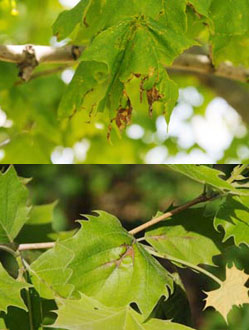
Anthracnose of Maple (top) and Sycamore (bottom)
photo: Univ. of Kentucky Nursery IPM
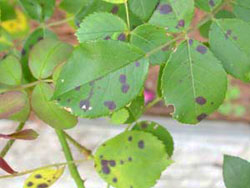
Black spot on Rose
photo: Purdue University
Fungal leaf spots (such as anthracnose, scab, leaf blotch, or shot hole) can vary in size, shape, and color.Some spots have distinct margins and may be surrounded by yellow halos. Other types of spots may be angular or blotchy. Spots or dead areas may enlarge to cover an entire leaf. As the spots become more abundant, leaves may yellow, die, and drop. Usually, leaf spots occur first on the lower leaves and progress up the plant. Fungal growth in the spot may consist of tiny pimple-like structures or a moldy growth of spores. You may need a hand lens or microscope to see the symptoms.
Leaf spots are more common in during early spring and fall when the moisture needed for infection is present. Fungal spores may overwinter in the infected leaves that drop around a plant. During spring, these pathogens produce infective spores that blow or splash onto healthy plants. If carried to healthy plants, these spores can begin a new infection under appropriate environmental conditions. Leaf spots occur on virtually all ornamental plants but not all leaf spot diseases affect plant health.
Leaf Blights
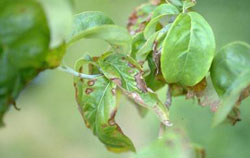
Dogwood anthracnose
photo: John Hartman, University of Kentucky, Bugwood.org
Leaf blights may have the same effect on plants as leaf spots but are generally larger diseased areas and have less regular shapes.
Dogwood anthracnose disease may begin as a leaf spot, become a leaf blight, and even progress to twigs and branches, causing dieback.
Rusts
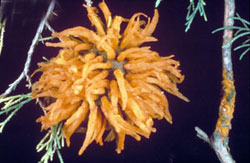
Cedar-apple rust with telial “horns” (left) and cedar-quince rust (right)
photo: Univ. of Georgia
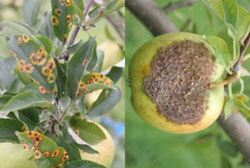
Cedar apple rust on apple foliage and fruit
photo: Univ. of Illinois
Rusts often produce spots called pustules that are similar to leaf spots. Pustules may be on the upper and/or lower leaf surface. They contain brown, reddish brown, orange, or yellow spores. Rust pustules are usually raised above the leaf surface. Rubbing the affected leaf surface will leave a dusty rust color (caused by the spores) on your fingers. Rust fungi may also attack twigs, branches, and fruit. They are often carried by wind and can be blown from infected plants to healthy plants, spreading the infection.
Rust diseases can have very complicated life cycles and, in many cases, require two separate hosts to complete their life cycle. In such cases, removing either one of the hosts can break the cycle and stop rust. Cedar-apple rust and related rusts are common ornamental disease problems.
Powdery Mildew
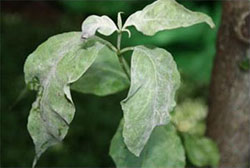
Dogwood powdery mildew
photo: UkNTrees
Powdery mildew The most common symptom is the white or gray layer of fungal growth produced on surfaces of the plant leaves and stems. Crooked stems or bubbled and curled leaves may develop If plant buds or very young tissue are infected.
Wind or rain splash can carry powdery mildew spores to new plants. During fall, the fungi produce small, black, overwintering structures that can overwinter in leaf debris or in cracks on bark.
Powdery mildew fungi are host specific, so different species infect different plant types. For example, powdery mildew fungi on dogwood will not infect Hydrangea, etc. Roses, oaks, tulip poplars, lilacs, zinnias, and euonymous are commonly affected by powdery mildew.
Leaf Gall Diseases
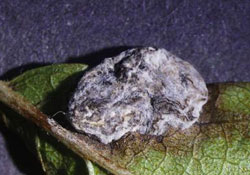
Leaf gall on lowbush blueberry
photo: Bruce Watt, University of Maine, Bugwood.org
Leaf gall diseases are caused by fungi and are favored by cool, moist weather. However, most galls seen on plants are caused by insects or mites.
Leaf galls caused by fungi can usually be seen shortly after new growth begins in the spring. Parts of leaves become distorted with a pale green to whitish bladder-like thickening. Young, thickened, fleshy leaves are covered with a white growth.
As galls age, they turn brown, dry up, and fall to the ground. If disease is severe, plant vigor can be affected due to leaf loss.
Dead, dry leaves that fall to the ground will be a source of spores for infection the following season. Leaf galls occur on azalea, camellia, and plum.
Root Rot
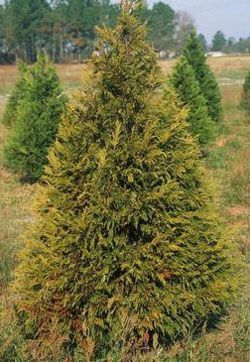
Phytophthora Root Rot
photo: John Ruter, University of Georgia, Bugwood.org
The first symptoms generally appear on above-ground plant parts as a gradual loss of vigor, yellowing of leaves, or wilting. Attempts to correct the problem with fertilizers and water generally yield little or no response.
In order to diagnose root rot diseases, plants must be dug carefully and soil washed from the roots. Diseased roots appear decayed, generally brown to black, and may be mushy or spongy. The fungus-like water molds Pythium and Phytophthora and the fungi Fusarium, Rhizoctonia, and Thielaviopsis are common root rotting organisms.
Excess soil moisture favors root rot disease on ornamental plants. Once soilborne fungi build up in landscapes, it is difficult to disinfest soil.
Stem Rot / Stem Blight
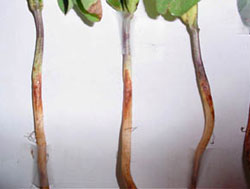
Stem Rot
photo: Matt Montgomery, Sangamon-Menard Extension
The pathogens commonly associated with stem rot of ornamentals include the fungus-like water molds Pythium and Phytophthora, and the fungi Rhizoctonia, Sclerotium, and Botrytis. All are common soil-inhabiting fungi.
They can be spread in infected debris, on cuttings, or when soil is moved. Once soilborne fungi build up in landscapes, it is difficult to disinfest soil.
Plants infected with stem rot fungi often show early symptoms of wilt. During advanced stages of disease, plants become more severely wilted and eventually die. The stems may be brown and shrunken at the soil line. Under extremely moist conditions, the white, cottony fungus mycelium may be visible on the surface of the stem.
Chrysanthemums, geraniums, petunias, and other herbaceous ornamental plants are very susceptible to stem rot.
Damping-off, a similar disease of seedlings, kills ornamental seedlings during the first few weeks after seed germination.
Cankers
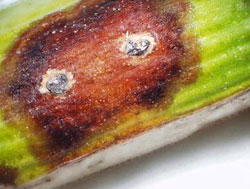
Stem canker on Japanese rose
photo: Elizabeth Bush, Virginia Polytechnic Institute and State University, Bugwood.org
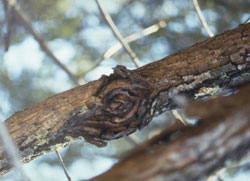
Canker on Walnut
photo: Paul A. Mistretta, USDA Forest Service, Bugwood.org
Cankers are localized sunken lesions areas on trunks, stems, or branches of woody plants. Canker diseases cause bark tissues to shrink and die. The dead tissues often crack open and expose the wood underneath.
Cankers begin as small, discolored yellow, brown, or red spots that sometimes appear water-soaked, although some canker disease are not visible outside of the bark. As cankers enlarge, their centers may become tan or gray. Small, black, pimple-like structures (fungal fruiting bodies that contain spores) may form in the canker. Cankers can enlarge and girdle stems, causing death to parts of the plant above the canker.
Fungi causing cankers usually infect through a wound or injury to the bark or wood. Rose canker is a common example of a disease showing this symptom.
Vascular Wilt Diseases
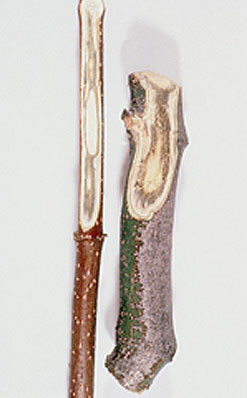
The Verticillium dahliae fungus causes this vascular wilt disease on hundreds of woody plants
photo: JW Pscheidt, U Mass.
Fungal pathogens such as Fusarium, Verticillium, and Ophiostoma can cause wilting of many ornamental species by restricting the water flow to leaves and stems. The wilting caused by such pathogens is sometimes due to the toxins they produce. Other pathogens can build up within water-conducting vessels, which become plugged by fungal growth.
Vascular wilt diseases often affect one side of the plant first, causing individual limbs or branches to wilt and die back. Fusarium and Verticillium infections usually begin in roots and gradually spread internally throughout the infected plant. Verticillium wilt of maple is an example.
Other wilt fungi infect through upper plant parts. Symptoms of vascular wilt disease often include discolored streaks in the wood of infected branches, which are visible upon cross-sectioning infected wood.
Bacteria
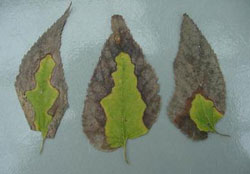
Bacterial leaf scorch
photo: John Hartman, University of Kentucky, Bugwood.org
Bacteria are single-celled organisms that usually reproduce by simple cell division, some as often as every 30 minutes. They can build up quickly under warm, humid weather conditions. Leaf, growing shoots, and fruit diseases are the most common types in Kentucky.
Bacteria can be carried from plant to plant in water droplets, by wind, rain splash, insects, or on equipment. They often survive between growing seasons in crop residue, in seeds or cuttings, or in weeds.
Viruses
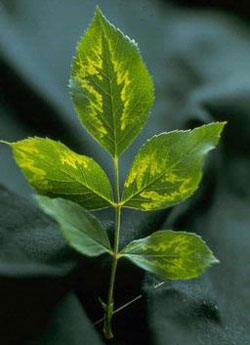
Rose mosaic virus
photo :William M. Brown Jr., Bugwood.org
Viruses are too small to see with a microscope. Generally, they are recognized by their effects on plants. These include stunted growth; change in plant color; abnormal formation of infected roots, stems, leaves, or fruit. Mosaic diseases, characterized by light and dark blotchy patterns, usually are caused by viruses.
It can be difficult to distinguish between diseases caused by viruses and those caused by other plant disease agents, such as fungi and bacteria. A positive diagnosis requires sophisticated testing, such as inoculating indicator plants and observing the results or using specifically identified antibodies to test for the presence of the organism.
Viruses depend upon living organisms for food and reproduction; they cannot exist very long outside a host. They are commonly spread from plant to plant by mites, aphids, leafhoppers, or whiteflies. A few are spread in the seeds of the infected plant.
Nematodes
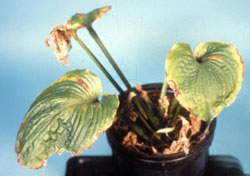
Foliar nematode damage on Hosta
photo: Department of Plant Pathology, North Carolina State University, Bugwood.org
The life cycle of a nematode includes an egg, several larval stages, and an adult. Most larvae look like small adults.
In adverse conditions, females of some species form inactive, resistant forms called cysts. The cyst is the hard, leathery, egg-filled body of the dead female, which is difficult to penetrate with pesticides. A cyst may protect eggs for as long as 10 years.
1) Which of the following causes a plant disorder?
2) _________ are the most common infectious organisms causing plant disease.3) _________ reproduce by spores.
4) _________ reproduce by simple cell division.
5) _________ is an example of a fungal disease.
6) ________ diseases are commonly spread by aphids or leafhoppers.
7) Wilting is an example of a disease sign.
8) Infection begins when the pathogen ___________.
9) _________ move from plant to plant on in water droplets, rain splash, or being carried by insects.
10) Powdery mildew, root rots, and stem rots are examples of diseases caused by __________.
11) Leaf spots are more common during the hot, dry parts of summer.
12) In many cases, ________ diseases require two separate host plants to complete their life cycle.13) A powdery mildew infection on dogwood will easily spread to zinnias or oaks in the landscape.
14) The first visible symptoms of root rot diseases usually appear as _______________.
- dark, mushy roots
- distorted leaves with a pale green to whitish bladder-like thickening
- loss of plant vigor, yellow or wilting leaves
- orange pustules on leaves
15) The pathogens commonly associated with stem rot of ornamentals are common soil-inhabiting fungi.
16) Plants with brown stems that are shrunken at the soil line are probably infected with ________ fungi.
17) ___________ diseases often affect one side of the plant first, causing individual limbs or branches to wilt and die back.
18) Vascular wilt infections usually begin in the _______ and gradually spread internally throughout the infected plant.
19) Leaf, growing shoots, and fruit diseases are the most common types of ___________ diseases in Kentucky.
20) Mosaic diseases, characterized by light and dark blotchy patterns, usually are caused by bacteria.
21) _________ diseases usually produce pustules on plant leaves.
22) Leaf rust is rarely is an explosive problem because it develops so slowly.
23) _________ is the first step in disease management.
24) Many different plant diseases cause similar symptoms.
website content by L. Townsend website design by P. Dillon copyright © 2016 University of Kentucky Department of Entomology
University of Kentucky College of Agriculture |
S-225 Agricultural Science Center North, Lexington, KY 40546-0091 | 859.257.7450
An Equal Opportunity University |
Last modified
11/30/2018
